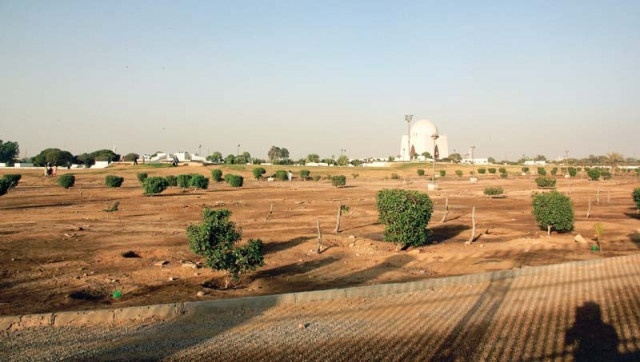Waterlogging puts greenery of Quaid’s mausoleum at risk
Pace of deterioration of environment has accelerated in past two years

Experts say that the lush green yard that once used to be the major attraction in the vicinity of the mausoleum is slowly being deserted. PHOTO: ATHAR KHAN/ EXPRESS
Mazar-e-Quaid lies in the centre of the city on MA Jinnah Road, where the founder of the nation, Quaid-i-Azam Mohammad Ali Jinnah is buried. Besides him, tombs of Mohtarma Fatima Jinnah, sister of the Quaid, the first prime minister of Pakistan, Liaquat Ali Khan, and Sardar Abdur Rab Nashtar, also lie in the same premises.
Senate panel reviews maintenance of Quaid's mausoleum
"It was being observed that the condition of Mazar-e-Quaid had been deteriorating for the past two years and, considering the pace of its deterioration, I wrote the first letter as a public interest complain to the Chief Justice of the Sindh High Court on July 3, 2015," said Abdul Hamid Dagia, a citizen of Karachi concerned about the condition of the mausoleum. "I mentioned that a large number of trees from a part of the garden of the Mazar-e-Quaid are vanishing whereas their trunks are left for no use." Dagia added that he had also pointed out that the trees on the boundary wall have also vanished.
Dagia was asked by the high court on November 7 to file a petition regarding the matter but he decided to write a letter to the Quaid-e-Azam Mazar management board on November 8 and asked them to improve the condition in 30 days, adding that he will file a petition otherwise.
According to Dagia, if you view the mazar via Google Earth satellite images, only the part of the mazar visited by the public is in a shambles while the part along the VIP gates is well maintained.
China to manufacture new chandelier for Quaid's mausoleum
Visitors also complained about the worsening condition of what was once considered one of the best picnic points in the city for families.
Sitting on a picnic mat along with his family, Muhammad Moeed told one of his kids to play football on the grassier surface instead of the dusty terrain. Moeed said that no doubt the garden is huge and greener areas can be preferred but most people choose to stay at this side as it is closer to the gate where they enter from. He added that it is sad that the whole part adjacent to the gate has become like a desert.
Another elderly man, Anwar Zaheer, who was spending time with his grandchildren, said that we have forgotten the respect this place should actually have. He mentioned that this place, which is a symbol of patriotism and where the whole nation visits to pay homage to the great leader, has been maligned in the past for vulgar activities. "[This] saddened people like me who witnessed this country growing from the beginning," he said. "If we continue to pay less attention to the places to which our sentiments are attached, one day this mausoleum will remain at its place while its garden will be [reduced to] a venue for political gatherings alone."
Meanwhile, a resident engineer of the Quaid-e-Azam Mazar management board, Muhammad Arif, told The Express Tribune that it is not the negligence of the board but a natural phenomenon that these trees have dried up.
Referring to the phenomenon of waterlogging, Arif said that since this part of the mazar is the lowest as compares to others, therefore all the underground water collects over here. He admitted that the situation is not new and that the board has been facing it for the last eight months. According to Arif, the solution to the problem is sucking the water out so that it allows the soil to consume air and further prepare it for agriculture. He added that when waterlogging happens, the roots of the plants become saturated, which does not allow it to grow as no air is available for the plant.
Arif claimed that they are working on renovating the part along Sharae Quaideen, adding that it will take around 20 to 30 days to rejuvenate the garden.
According to ecologist Rafiul Haq, who also belongs to Horticulture Society of Pakistan, asked why only a specific part of the garden is affected by waterlogging. He added that the walls of the mausoleum are erect and fine, which is an indication that there are less chances of waterlogging as walls cannot stand for a longer period of time in waterlogged areas. He also said that mature tree can survive waterlogging and can change position accordingly while it is difficult for younger trees to manage as their roots suffocate. He added that term waterlogging is 'premature'.
Even if the area is waterlogged, the Mazar authorities should prefer planting Eucalyptus, which can grow in waterlogged areas, he said. He added that if authorities will pay attention and take advice from environmentalists or ecologists, they will be able to solve these issues technically.
Published in The Express Tribune, November 24th, 2016.



















COMMENTS
Comments are moderated and generally will be posted if they are on-topic and not abusive.
For more information, please see our Comments FAQ